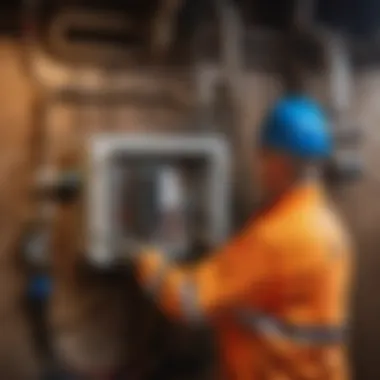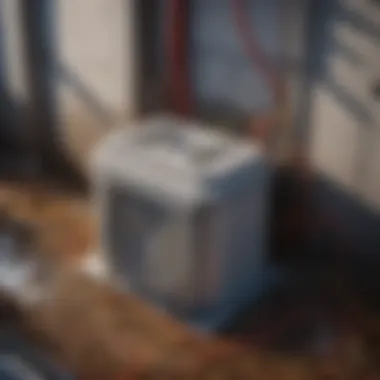Unveiling the Vital Role of Septic System Junction Boxes in Ensuring Proper Functionality


Materials:
- Concrete junction box (dimensions: 18" x 16" x 12")
- PVC piping (1 ½ inches diameter, length: as per requirement)
- Septic tank sealant
- Silicone caulking
- Plastic gloves
- Safety goggles
- Waterproof concrete mix
- Small hand trowel
DIY Steps:
- Choosing the Right Location: Begin by selecting a suitable location for the junction box near the septic tank. Ensure it’s easily accessible for future maintenance.
- Digging the Hole: Excavate a hole according to the dimensions of the junction box, accounting for the piping layout and depth requirements.
- Placing the Junction Box: Carefully position the concrete junction box in the dug-out hole, ensuring it's at the correct level for connecting pipes.
- Connecting the Pipes: Use the PVC piping to connect the inlet and outlet pipes of the septic system to the junction box, ensuring a secure and watertight fit.
- Sealing and Finishing: Apply septic tank sealant and silicone caulking around the pipe connections to prevent leakage. Finish by waterproofing the concrete junction box.
Technical Aspects:
- Tools Required: Shovel, level, tape measure, PVC pipe cutter, caulking gun
- Timing Specifics: Allow 2-3 days for the concrete to fully set before backfilling
- Critical Techniques: Ensure proper slope for gravity flow, watertight seals at all joints
DIY Project Process:


- Installation Method: Follow the step-by-step instructions to correctly install the junction box, considering proper alignment and sealants.
- Key Techniques: Maintain precise measurements during pipe cutting and ensure a secure fit at all connections.
- Timings: Allow sufficient time for concrete curing and sealant drying before initiating system use.
- Troubleshooting Tips: In case of leaks, reapply sealant; for improper fit, readjust piping connections.
Introduction


In the realm of septic systems, junction boxes play a pivotal role in ensuring the seamless operation of the overall system. This section will delve into the intricate details surrounding septic system junction boxes, shedding light on their significance and functionality within a broader septic system framework. Understanding the purpose and composition of these junction boxes is fundamental for homeowners looking to maintain their septic systems effectively.
Understanding Septic System Junction Boxes
Definition and Purpose
Septic system junction boxes are essential components that serve as connection points for various pipes within the system. They effectively act as hubs for the distribution of wastewater and play a crucial role in the system's functionality. Their primary purpose lies in facilitating the proper flow of effluent between different components of the septic system, ensuring efficient operation.
One key characteristic of septic system junction boxes is their durability and resistance to corrosion, which makes them a popular choice among septic system installers. Their ability to withstand harsh underground conditions and their leak-proof design contribute to their reliability within septic systems. While these junction boxes offer a sturdy solution for connecting pipes, their installation and placement require careful consideration to optimize their functionality within the system.
Importance in Septic Systems
The importance of septic system junction boxes cannot be understated in the realm of septic systems. They act as central points that enable the smooth flow of wastewater from the main septic tank to other system components. Without properly installed and maintained junction boxes, the efficiency of the entire septic system can be compromised.
A key characteristic of these junction boxes is their role in preventing clogs and backups by facilitating the proper routing of wastewater. Their strategic placement and robust design contribute to the optimal performance of septic systems, reducing the risk of costly repairs due to malfunctions or blockages. Homeowners must recognize the significance of junction boxes in maintaining the health and longevity of their septic systems.
Basic Components
Material Composition
The material composition of septic system junction boxes is a critical aspect that influences their performance and longevity in septic systems. Typically constructed from durable materials such as concrete, plastic, or fiberglass, these junction boxes are designed to withstand the corrosive nature of wastewater and the pressure exerted by soil and environmental factors.
One key characteristic of the material composition of junction boxes is their resistance to chemical degradation, ensuring long-term functionality within septic systems. The choice of material for junction boxes depends on factors such as soil composition, site conditions, and installation requirements. Each material offers unique advantages and disadvantages, making it essential for homeowners to select the most suitable option for their specific septic system needs.
Design Features
The design features of septic system junction boxes encompass various elements that contribute to their efficiency and functionality within septic systems. From multiple inlet and outlet ports to secure locking mechanisms, these design features are tailored to streamline the operation of the junction boxes and ensure smooth wastewater flow.
One key characteristic of the design features is their modularity, allowing for easy expansion or modification of the septic system as needed. The versatility of these design elements facilitates the installation and maintenance of junction boxes, providing homeowners with a user-friendly solution for managing their septic systems. By incorporating robust design features, junction boxes enhance the overall performance and durability of septic systems, offering a reliable solution for wastewater management.
Installation Process


In the realm of septic system maintenance, the installation process holds paramount importance. This section delves into the critical steps involved in setting up septic system junction boxes, ensuring optimal functionality and longevity. The meticulous planning and execution of the installation process are pivotal in guaranteeing the smooth operation of the entire septic system.
Seamless installation of junction boxes is essential for proper waste management and filtration within septic systems. By establishing a robust framework during installation, housewives and homeowners can safeguard their properties from potential sewage system failures and environmental hazards. Attention to detail in the installation process not only enhances the efficiency of the septic system but also minimizes the need for costly repairs in the future.
Efficient installation practices contribute significantly to the overall performance and durability of septic system junction boxes. By adhering to recommended installation guidelines and industry best practices, individuals can ensure the seamless integration of junction boxes into their septic systems. Thorough understanding of the installation process equips housewives and homeowners with the knowledge required to maintain a sustainable and functional sewage disposal system.
Placement Considerations
Distance from Main Septic Tank
The distance from the main septic tank is a critical factor to consider when positioning junction boxes within the septic system. This parameter directly impacts the efficiency of waste disposal and the overall functionality of the system. Placing the junction box at an optimal distance ensures the proper flow of effluent through the system, preventing clogs and backups.
One key characteristic of strategically locating the junction box in proximity to the main septic tank is the facilitation of seamless waste transfer. By minimizing the distance, housewives and homeowners can enhance the operational efficiency of their septic systems, promoting faster filtration and treatment of wastewater. This strategic placement not only optimizes system performance but also simplifies maintenance tasks.
Depth of Burial: Achieving the ideal depth of burial for the junction box is essential for maintaining system integrity and longevity. By burying the junction box at the appropriate depth, housewives and homeowners can protect the system components from external damage and facilitate proper functioning. The depth of burial plays a significant role in safeguarding the junction box against external elements, ensuring its durability over time.
Connection Procedures
Piping Installation
Piping installation is a critical aspect of linking the junction box to the main septic system, enabling the seamless flow of wastewater. Proper piping installation ensures the efficient transfer of effluent between system components, promoting optimal waste management. The key characteristic of effective piping installation lies in the precise alignment and secure connection of pipes, preventing leaks or blockages.
The unique feature of piping installation is its versatility in accommodating varying system layouts and configurations. By customizing the piping installation process according to specific requirements, housewives and homeowners can tailor their septic systems to meet their property's needs. This adaptability in piping installation enhances the overall efficiency and functionality of the septic system.
Electrical Wiring
Electrical wiring plays a vital role in providing power to essential components within the septic system, including alarms and pumps. Properly connecting electrical wiring ensures the seamless operation of these critical elements, contributing to the system's overall efficiency and reliability. The key characteristic of efficient electrical wiring lies in the safe and secure connection of wires, adhering to safety standards and regulations.
The unique feature of electrical wiring is its role in enabling automated functions within the septic system, such as alarm systems for overflow prevention. By implementing robust electrical wiring procedures, housewives and homeowners can ensure the consistent performance of their septic systems, minimizing the risk of malfunctions or disruptions.
Maintenance Tips
When it comes to septic system maintenance, diligent care is essential to ensure the longevity and efficiency of the system. Maintenance tips play a vital role in preventing costly repairs and maintaining optimal functionality. By following a consistent maintenance schedule, homeowners can avoid major issues and prolong the life of their septic system. Regular check-ups are imperative for early detection of any potential problems that may arise. These routine inspections help identify issues before they escalate, promoting the overall health of the septic system. Significantly, regular check-ups also contribute to cost-effectiveness by addressing minor concerns promptly, thus avoiding extensive repairs down the line.
Inspection Guidelines
Regular Check-ups
Regular check-ups are a cornerstone of effective septic system maintenance. By inspecting the system at regular intervals, homeowners can identify any warning signs or potential issues before they become serious problems. This proactive approach allows for timely intervention and rectification, ultimately preserving the functionality and efficiency of the septic system. The key characteristic of regular check-ups lies in their preventative nature, actively preventing system failures and avoiding unexpected emergencies. Although regular inspections require time and effort, the benefits far outweigh the costs, making them a popular choice for homeowners looking to safeguard their investment. The unique feature of regular check-ups is their ability to provide peace of mind, knowing that the septic system is well-maintained and functioning optimally.
Signs of Malfunction
Recognizing signs of septic system malfunction is crucial for prompt troubleshooting and maintenance. Being able to identify symptoms such as slow drainage, foul odors, or pooling water can help homeowners address underlying issues before they worsen. Understanding the key characteristics of these signs enables homeowners to take swift action, preventing potential damage to the system. Despite the disadvantages of dealing with malfunctions, such as disruptions and expenses, having a keen eye for signs of malfunction is indispensable in preserving the septic system's health. By remaining vigilant and responsive to these signals, homeowners can mitigate risks and ensure their system operates smoothly.
Cleaning and Troubleshooting
Debris Removal
Effective debris removal is vital to maintaining a healthy septic system. Clearing out any accumulated solids or debris helps prevent clogs and promotes proper system functionality. The key characteristic of debris removal is its proactive nature, preventing blockages that can impede the system's operations. By regularly removing debris, homeowners can extend the lifespan of their septic system and avoid unnecessary repairs. While the process of debris removal may require time and effort, its advantages in sustaining system performance make it a crucial maintenance task.
Identifying Blockages
Identifying and addressing blockages promptly is essential for preventing system backups and ensuring proper function. Blockages can impede the flow of wastewater, leading to potential overflows and damage. The key characteristic of identifying blockages lies in its role as a preventative measure, averting major disruptions to the septic system's operations. Despite the challenges associated with blockage identification, such as the need for thorough inspection and potential troubleshooting, this task is indispensable for maintaining system efficiency. By staying diligent in identifying and rectifying blockages, homeowners can preserve the health and functionality of their septic system.
Troubleshooting Common Issues
In the realm of septic system maintenance, troubleshooting common issues holds a paramount significance in ensuring the seamless operation of the entire system. This section of the article focuses on addressing and rectifying problems that may arise in septic system junction boxes, thereby playing a crucial role in maintaining the system's efficiency and longevity. By delving into specific elements such as overflow problems and odor concerns, readers can gain valuable insights into identifying, resolving, and preventing issues that could potentially disrupt the functionality of their septic systems.
Overflow Problems
When it comes to septic systems, overflow problems can have serious repercussions if not promptly addressed. This subsection sheds light on the causes and solutions associated with overflow issues. By exploring the specific aspects of why overflows occur and the potential consequences they pose, readers can grasp the importance of taking proactive measures to mitigate such challenges.
Causes and Solutions
The causes of overflow problems in septic system junction boxes can vary, ranging from blockages in the piping system to excessive wastewater input beyond the system's capacity. It is crucial to identify the root cause accurately to implement effective solutions. One common solution involves inspecting the system for clogs or obstructions and then clearing them to restore proper flow. Additionally, adjusting the wastewater input rate or considering system upgrades can help prevent future overflow incidents. The key characteristic of addressing overflow problems lies in the timely response and strategic intervention to prevent potential damage to the septic system as a whole.
Odor Concerns
Another critical aspect of septic system maintenance revolves around addressing odor concerns, as foul smells can indicate underlying issues within the system. This section outlines the importance of identifying the source of odors and employing remediation techniques to eliminate these unpleasant odors completely to maintain a healthy and functional septic system.
Identifying Source
The identification of the odor source is essential in tackling odor concerns effectively in septic system junction boxes. By pinpointing whether the odors emanate from the junction box itself or other components of the system, homeowners can take targeted actions to address the underlying problems. This process involves inspecting the junction box and associated pipes for potential leaks or seepages that could be releasing odorous gases. By understanding the key characteristic of where the odors originate, individuals can implement appropriate measures to seal leaks, repair damaged components, or adjust ventilation to eradicate the source of unpleasant smells.
Remediation Techniques
Effective remediation techniques play a crucial role in eliminating odor concerns in septic systems. From using enzymatic cleaners to neutralize odors to physically repairing damaged pipes or components, various solutions exist to combat foul smells and restore a pleasant environment. The unique feature of remediation techniques lies in their ability to not only address existing odors but also prevent their recurrence by ensuring proper system functioning and maintenance. By leveraging suitable remediation methods, homeowners can enjoy a odor-free environment, indicating a well-maintained and efficient septic system.
Conclusion
Significance of Proper Maintenance
Ensuring System Efficiency
Maintaining system efficiency is a key aspect when it comes to the proper care of septic system junction boxes. Ensuring that these components function optimally helps in preventing backups, overflows, and other potential hazards. The efficient operation of junction boxes contributes to the smooth flow of wastewater within the septic system, reducing the risk of blockages and disruptions. Homeowners can benefit from improved system performance and reliability by prioritizing the maintenance of these critical components.
Avoiding Costly Repairs
One major advantage of implementing proper maintenance practices for septic system junction boxes is the avoidance of costly repairs. Neglecting regular inspections and cleaning can lead to malfunctions or failures in these components, requiring extensive repairs or even replacements. By proactively addressing maintenance needs and addressing issues promptly, homeowners can prevent the escalation of minor problems into major, expensive repairs. This preventive approach not only saves money in the long term but also ensures the uninterrupted functionality of the septic system. Taking proactive steps to avoid costly repairs through diligent maintenance is a prudent investment in the longevity and efficiency of the entire septic system.



